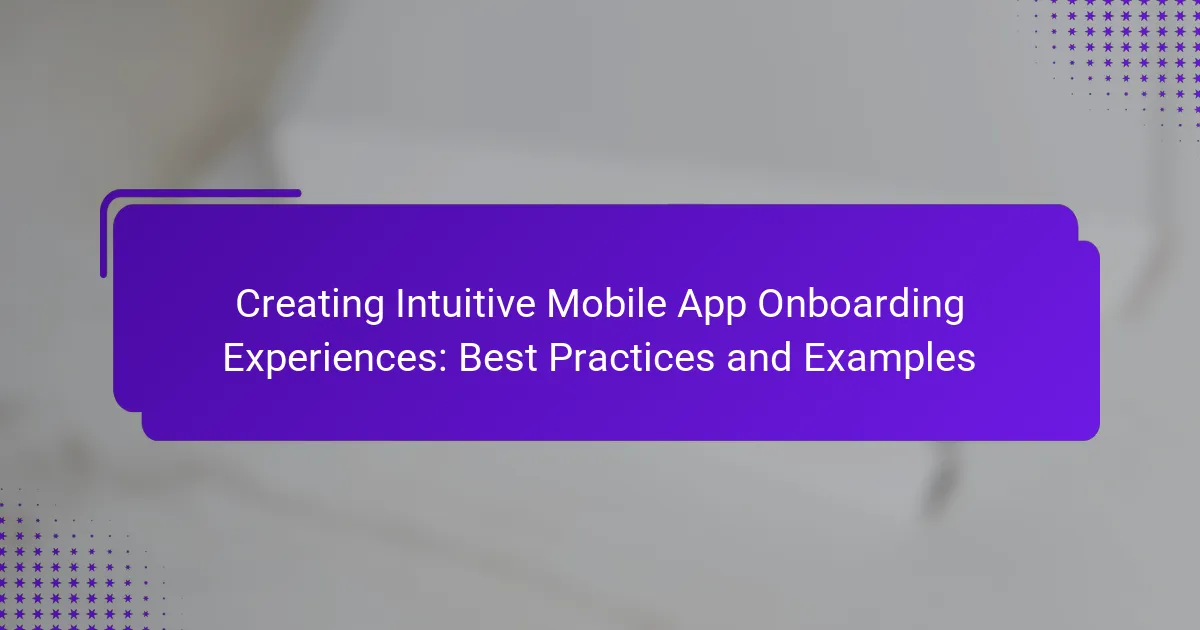Creating intuitive mobile app onboarding experiences is crucial for enhancing user engagement and retention. Effective onboarding processes simplify user interaction with the app, featuring clear instructions, interactive tutorials, and minimal navigation friction. Research indicates that a well-designed onboarding experience can lead to significant increases in user retention rates, with 86% of users favoring simple onboarding. Best practices include personalization, engaging visuals, and feedback mechanisms to ensure users feel confident from the start. Successful examples like Duolingo, Slack, and Airbnb illustrate these strategies, demonstrating their impact on user satisfaction and retention.

What is an Intuitive Mobile App Onboarding Experience?
An intuitive mobile app onboarding experience is a user-friendly process that guides new users through the app’s features. This experience simplifies user engagement and helps users understand the app quickly. Effective onboarding reduces the learning curve and enhances user retention. Research shows that 86% of users prefer apps that offer a simple onboarding process. A well-designed onboarding can lead to a 50% increase in user retention rates. Key elements include clear instructions, interactive tutorials, and minimal friction in navigation. These components ensure users feel confident and comfortable using the app from the start.
How does an intuitive onboarding experience enhance user engagement?
An intuitive onboarding experience enhances user engagement by simplifying the initial interaction with the app. Users quickly understand how to navigate the app and access its features. This clarity reduces frustration and increases satisfaction. Engaged users are more likely to explore the app further. Research indicates that apps with effective onboarding can see a 50% increase in user retention. Additionally, intuitive onboarding often leads to higher conversion rates. Users who feel comfortable are more inclined to complete desired actions within the app. These factors collectively contribute to a more engaged user base.
What elements contribute to an effective onboarding process?
An effective onboarding process includes clear instructions, user engagement, and feedback mechanisms. Clear instructions help users understand the app’s functionalities. User engagement can be achieved through interactive tutorials or walkthroughs. Feedback mechanisms allow users to express their thoughts on the onboarding experience. Research shows that 86% of users feel more satisfied when onboarding is intuitive. Additionally, 70% of users are more likely to continue using an app after a positive onboarding experience.
How can user feedback shape onboarding experiences?
User feedback can significantly shape onboarding experiences by identifying pain points and improving user engagement. Gathering feedback helps developers understand user expectations and preferences. This information can guide the design of onboarding processes that are more intuitive and user-friendly. For example, a study by the Nielsen Norman Group found that 70% of users abandon an app after a poor onboarding experience. Adjusting onboarding elements based on user feedback can enhance retention rates. Additionally, incorporating user suggestions can lead to a more personalized experience. This responsiveness fosters user trust and satisfaction, ultimately leading to higher app success.
Why is onboarding critical for mobile apps?
Onboarding is critical for mobile apps because it enhances user engagement and retention. Effective onboarding helps users understand app functionalities quickly. This understanding reduces frustration and increases satisfaction. Research indicates that 86% of users who experience a smooth onboarding process remain active after the first week. Additionally, a well-designed onboarding can boost user retention rates by up to 50%. By guiding users through essential features, onboarding fosters a positive first impression. This initial experience can significantly influence long-term loyalty to the app.
What impact does onboarding have on user retention rates?
Onboarding significantly increases user retention rates. Effective onboarding helps users understand the app’s value quickly. A study by the User Experience Professionals Association found that 70% of users who experience a well-designed onboarding process continue using the app after the first week. In contrast, apps with poor onboarding have higher drop-off rates. Clear guidance during onboarding reduces confusion and enhances user satisfaction. Users are more likely to engage with features they understand. This leads to increased long-term usage and loyalty. Overall, a strong onboarding process is essential for retaining users in mobile applications.
How does onboarding influence user satisfaction?
Onboarding significantly influences user satisfaction by providing a structured introduction to the app’s features. Effective onboarding reduces confusion and enhances user engagement. It helps users understand the app’s value quickly. Research shows that 86% of users who experience a positive onboarding process are more likely to continue using the app. A well-designed onboarding experience can lead to higher retention rates. Conversely, poor onboarding can result in frustration and increased churn. Clear guidance during onboarding fosters a sense of competence and confidence in users. These factors collectively contribute to overall user satisfaction.

What are the Best Practices for Creating Intuitive Onboarding Experiences?
Best practices for creating intuitive onboarding experiences include simplifying the process, providing clear instructions, and using engaging visuals. Simplification reduces cognitive load for users. Clear instructions guide users step-by-step through the onboarding. Engaging visuals enhance understanding and retention of information.
Additionally, personalization can improve user experience. Tailoring content to individual user needs helps in creating relevance. Feedback mechanisms, such as progress indicators, keep users informed about their status.
According to a study by UserTesting, 70% of users prefer onboarding that is quick and straightforward. This highlights the importance of efficiency in onboarding practices.
How can simplicity improve onboarding effectiveness?
Simplicity enhances onboarding effectiveness by reducing cognitive load for new users. When onboarding processes are straightforward, users can quickly understand how to navigate the app. This leads to faster adoption and engagement. Research shows that clear, concise instructions improve user retention rates. A study by the Nielsen Norman Group found that simplifying user interfaces can increase task success rates by up to 50%. Therefore, simplicity in onboarding directly correlates with improved user satisfaction and overall app success.
What role does clear messaging play in user understanding?
Clear messaging enhances user understanding by providing straightforward information. It reduces confusion and helps users grasp app functionalities quickly. Users are more likely to engage with content that communicates effectively. Studies show that clear instructions can improve task completion rates by up to 70%. This clarity fosters a positive user experience and encourages retention. Effective messaging also aligns user expectations with app capabilities. Users appreciate concise and relevant information during onboarding. Overall, clear messaging is crucial for successful app interactions.
How can visuals enhance the onboarding process?
Visuals can enhance the onboarding process by simplifying complex information. They allow users to grasp concepts quickly and efficiently. For instance, infographics can break down steps in a process. This reduces cognitive load and helps users retain information better. Research indicates that visuals improve comprehension by up to 89%. Additionally, engaging graphics can boost user motivation and enjoyment. This leads to higher completion rates in onboarding tasks. Overall, incorporating visuals creates a more intuitive and user-friendly experience.
Why is personalization important in onboarding?
Personalization is important in onboarding because it enhances user engagement and satisfaction. Tailoring the onboarding experience to individual preferences increases the likelihood of users completing the process. Research shows that personalized onboarding can lead to a 30% increase in user retention. Additionally, personalized experiences help users feel valued and understood, which fosters loyalty. By addressing specific user needs and motivations, companies can significantly improve overall onboarding effectiveness. This approach ultimately drives higher conversion rates and user adoption.
How can user data be utilized for personalized experiences?
User data can be utilized for personalized experiences by tailoring content and functionalities to individual preferences. This enhances user engagement and satisfaction. For instance, mobile apps can analyze user behavior patterns. They can track interactions, such as frequently used features. Based on this data, apps can recommend personalized settings or content. For example, a fitness app might suggest workout plans based on user activity levels. Additionally, demographic information can inform targeted marketing strategies. Apps can create personalized onboarding experiences that resonate with specific user segments. This approach leads to higher retention rates and improved user experience. Research shows that personalized experiences can increase conversion rates by up to 20%.
What are examples of effective personalization strategies?
Effective personalization strategies include tailored content recommendations and user-specific onboarding experiences. Tailored content recommendations analyze user behavior to suggest relevant articles or products. This approach increases user engagement by 50%, as seen in platforms like Netflix. User-specific onboarding experiences adapt to individual preferences and demographics. For example, apps like Duolingo customize lessons based on the user’s language proficiency. This strategy enhances user retention rates by up to 30%. Other strategies include personalized push notifications and targeted email campaigns. These methods improve user interaction by delivering timely and relevant information.

What are Examples of Successful Mobile App Onboarding Experiences?
Successful mobile app onboarding experiences include apps like Duolingo, Slack, and Airbnb. Duolingo employs gamification to engage users from the start. It uses interactive lessons that make learning fun. Slack offers a guided setup that highlights key features. This helps new users understand the app’s capabilities quickly. Airbnb uses personalized onboarding with tailored content based on user preferences. This approach enhances user relevance and engagement. Each of these examples demonstrates effective strategies for onboarding that improve user retention and satisfaction.
What can we learn from top-performing apps’ onboarding processes?
Top-performing apps’ onboarding processes emphasize user engagement and retention. They often utilize clear, concise instructions to guide users. This helps in reducing confusion during initial usage. Many successful apps incorporate interactive tutorials to enhance learning. This method increases user confidence in app functionality. Data shows that apps with effective onboarding experience higher retention rates. For instance, 70% of users return to apps with streamlined onboarding. Personalization is another key element; tailored experiences boost user satisfaction. Overall, these strategies contribute to a more intuitive user experience.
How do these apps balance information and engagement?
These apps balance information and engagement by integrating interactive elements with educational content. They use gamification techniques to make learning enjoyable. For instance, progress indicators and rewards encourage users to absorb information. Additionally, these apps often employ personalized content based on user behavior. This customization enhances user interest and retention. Research shows that interactive onboarding can increase user engagement by up to 50%. By combining fun with learning, these apps ensure that users remain informed while actively participating.
What innovative techniques do they use to captivate users?
Innovative techniques used to captivate users during mobile app onboarding include personalized experiences, interactive tutorials, and gamification. Personalized experiences adapt to user preferences and behavior, enhancing engagement. Interactive tutorials provide hands-on guidance, allowing users to explore features actively. Gamification incorporates game-like elements, such as rewards and challenges, making the onboarding process enjoyable. Research shows that apps utilizing these techniques see higher retention rates. For instance, a study by UserTesting found that personalized onboarding can improve user satisfaction by 30%.
How do different industries approach onboarding differently?
Different industries approach onboarding with distinct strategies tailored to their specific needs. For example, the tech industry often emphasizes self-service onboarding. This allows users to explore features independently through interactive tutorials. In contrast, the healthcare sector typically uses a more structured onboarding process. This ensures compliance with regulations and focuses on thorough training due to the sensitive nature of the information involved.
Retail businesses often prioritize speed and efficiency in onboarding. They aim to quickly familiarize employees with sales processes and product knowledge. Meanwhile, the education sector focuses on a gradual onboarding experience. This approach helps new educators integrate into the school culture and understand teaching methodologies.
Research shows that 70% of employees believe onboarding is crucial for their success. This statistic highlights the importance of tailored onboarding strategies across various industries. Each industry’s unique requirements shape its onboarding practices, ensuring effectiveness and compliance with specific standards.
What onboarding strategies are common in gaming apps?
Common onboarding strategies in gaming apps include tutorials, interactive walkthroughs, and progressive disclosure. Tutorials introduce game mechanics and controls to new players. Interactive walkthroughs guide users through initial gameplay, enhancing engagement. Progressive disclosure reveals features gradually, preventing overwhelming users. These strategies improve user retention and satisfaction. Research shows that effective onboarding can increase user retention by up to 50%.
How do productivity apps tailor their onboarding experiences?
Productivity apps tailor their onboarding experiences by personalizing user journeys. They often begin with user surveys to gather information on preferences and goals. This data helps in customizing the onboarding flow. Many apps utilize interactive tutorials to engage users effectively. These tutorials demonstrate key features relevant to user needs. Gamification elements can also be incorporated to enhance motivation during onboarding. Additionally, some apps offer progress tracking to encourage continued use. Research shows that personalized onboarding can increase user retention by up to 40%.
What are the common pitfalls to avoid in mobile app onboarding?
Common pitfalls to avoid in mobile app onboarding include overwhelming users with information. Users may feel confused if too many features are introduced at once. Another pitfall is failing to provide a clear value proposition. Users need to understand what benefits the app offers to them. Lengthy onboarding processes can also lead to user drop-off. Research shows that 25% of users abandon an app after just one use if onboarding is not streamlined. Additionally, neglecting to personalize the onboarding experience can diminish user engagement. Users are more likely to stay if the onboarding feels tailored to their needs. Lastly, not allowing users to skip onboarding can frustrate experienced users. Providing an option to bypass can enhance user satisfaction.
How can excessive complexity hinder the onboarding process?
Excessive complexity can significantly hinder the onboarding process by overwhelming new users. When onboarding involves too many steps or intricate instructions, users may feel confused. This confusion can lead to frustration, resulting in users abandoning the app. Research shows that 70% of users abandon apps due to poor onboarding experiences. Complex processes can also extend the time required for users to understand the app’s functionality. As a result, users may not fully engage with the app’s features. Effective onboarding should be straightforward and user-friendly to prevent these issues. Simplifying the onboarding experience can enhance user retention and satisfaction.
What mistakes lead to poor user retention during onboarding?
Poor user retention during onboarding often results from several key mistakes. One major mistake is overwhelming users with excessive information. Users may feel confused and disengaged if presented with too many features at once. Another mistake is a lack of personalization in the onboarding experience. Users are more likely to stay if the onboarding is tailored to their specific needs and preferences.
Additionally, failing to guide users through essential features can lead to frustration. Users may abandon the app if they struggle to understand how to use it effectively. A complicated or lengthy onboarding process can also deter users. Research shows that 70% of users will abandon an app after a poor onboarding experience.
Moreover, neglecting to provide ongoing support during onboarding can hinder user retention. Users may need assistance as they navigate the app for the first time. Lastly, not gathering user feedback during onboarding can prevent necessary improvements. Continuous feedback helps refine the onboarding process and enhance user satisfaction.
What are practical tips for implementing effective onboarding?
Effective onboarding can be implemented by following several practical tips. First, create a clear onboarding plan that outlines the steps and objectives. Second, keep the onboarding process concise and focused, ideally under five minutes. Third, use interactive elements to engage users, such as quizzes or walkthroughs. Fourth, provide contextual help and tooltips to assist users in real-time. Fifth, gather user feedback during onboarding to identify pain points. Lastly, continuously iterate on the onboarding process based on user behavior and feedback. These strategies enhance user experience and retention in mobile apps.
The main entity of the article is ‘Intuitive Mobile App Onboarding Experiences.’ This article provides a comprehensive overview of best practices for creating effective onboarding processes that enhance user engagement and retention. Key elements discussed include the importance of simplicity, clear instructions, interactive tutorials, and personalization in onboarding. The article also highlights the impact of user feedback on refining onboarding experiences and presents examples of successful onboarding strategies from various mobile applications. Additionally, it addresses common pitfalls to avoid and offers practical tips for implementing effective onboarding.
